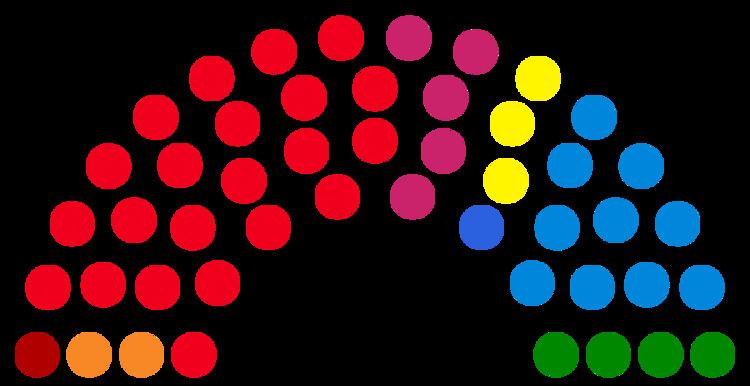Type Municipal city council Last election 5 June 2016 | Seats 48 | |
 | ||
President Lamberto Bertolè, PDSince 7 July 2016 Political groups Government (29) PD (22) NM (5) SI (2)Opposition Parties FI (10) LN (4) M5S (3) NCD (1) PRC (1) Next election No later than June 2021 | ||
The City Council of Milan (Italian: Consiglio Comunale di Milano ) is the top-tier administrative body of the municipality of Milan, Lombardy, Italy. It consists of the elected Mayor of Milan and an elected 48-member assembly. It represents a legislative body which can also control Mayor's policy guidelines and be able to enforce his resignation by a motion of no confidence.
Contents
The City Council is elected for a five-years term and is based on a direct choice for the candidate with a preference vote: the candidate with the majority of the preferences is elected. The number of the seats for each party is determined proportionally.
The City Council meets at Palazzo Marino, seated in Piazza della Scala.
Composition
The political system of the Comuni of Italy was changed in 1993, when a semi-presidential system for the mayoral election was introduced. If until that year the Council was elected under a pure proportional system and the Council had the power to elect and dismiss the Mayor of Milan, since 1993 the Mayor and the Council are jointly elected by citizens, with an electoral law that assures to the elected Mayor a political majority in the Council.
Under this system, the election of the Mayor is prior over the election of the Council. Voters express a direct choice for the Mayor or an indirect choice voting for the party of the candidate's coalition and this gives a result whereby the winning candidate is able to claim majority support in the new Council. The candidate who is elected Mayor has always a majority of 62% of seats (29 seats) in the City Council, which will support him during his term. The seats for each party of the coalition which wins the majority is determined proportionally.
In this type of system, the Council is generally elected for a five-year term, but, if the Mayor suffers a vote of no confidence, resigns or dies, under the simul stabunt, simul cadent clause introduced in 1993 (literally they will stand together or they will fall together), also the Council is dissolved and a snap election is called.
The City Committee (Italian: giunta comunale), the executive body of the city, chosen and presided directly by the Mayor, is generally composed by members of the City Council, which maintain the power to vote inside the assembly.
Functions
The Council acts as the supreme legislative body of the city. It is convened and chaired by a speaker (president del consiglio comunale) appointed by the Council itself.
The Council can decide over programs and public works projects, institution and system of taxes, the general rules for the use of goods and services, forecasting and reporting financial statements. Resolution basic acts attributed by law to its competence are the municipal statute, the regulations, the general criteria on the structure of offices and services.
After the creation of the Metropolitan City of Milan in 2015, which with its new Metropolitan Council has the power to coordinate the municipalities around Milan in providing basic services (including transport, school and social programs) and environment protection, and the 2016 municipal administrative reform, which delegated to the 9 administrative Boroughs Councils of Milan a large spectrum of functions related to local services, such as schools, social services, waste collection, roads, parks, libraries and local commerce, the functions of the City Council of Milan has been drastically reduced.
City Hall
The City Council is seated at Palazzo Marino, a 16th-century palace located in Piazza della Scala, in the centre of Milan, Italy. Palazzo Marino has been Milan's city hall since 9 September 1861. It borders on Piazza San Fedele, Piazza della Scala, Via Case Rotte and Via Tommaso Marino.
The palace was built for, and is named after, the Genoan trader and banker Tommaso Marino. It became a property of the State in 1781.
Speakers
This is a list of the speakers (Italian: presidenti del consiglio comunale) of the City Council since the 1993 electoral reform:
Current composition
Note: if a defeated candidate for Mayor obtained over 3% of votes, he/she is automatically elected city councilor.
The candidate elected Major is not a member of the City Council, but has the right to vote in the City Council; if Stefano Parisi, who was elected in the City Council as the candidate of the first defeated coalition, will resign, his seat in the City Council will pass to Riccardo De Corato (former Deputy Major from 1997 to 2011), first candidate of Brothers of Italy (FdI), because this list is the first list in the coalition under the electoral threshold.
